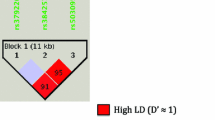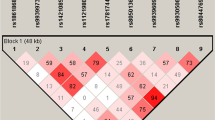Abstract
Background: Haplotypes of adiponectin gene single nucleotide polymorphisms (SNP) might be related to metabolic disorders. Aim: To assess whether the prevalence of SNP 45T/G and 276G/T of the adiponectin gene and their haplotypes differ between polycystic ovary syndrome (PCOS) and non-hirsute cycling controls and to investigate the relationship between these haplotypes and risk factors for cardiovascular disease. Subjects and methods: In this case-control study, 80 women with PCOS and 1500 non-hirsute controls with regular cycles underwent clinical and laboratory measurements. Genotype distribution was analyzed by conventional PCR-restriction fragment length polymorphism. Results: Compared to controls, PCOS women had greater body mass index (BMI) (31.0±7.9 kg/m2 vs 23.4±4.6 kg/m2; p<0.001), waist circumference (92.2±18.8 cm vs 74.5±10.2 cm; p<0.001), and systolic and diastolic blood pressure (124.6±19.9 vs 111.5±13.0 mmHg and 79.2±12.5 vs 71.8±10.6 mmHg; p<0.025), as well as a worse lipid profile (p<0.007), even after adjustment for age and BMI. Genotype distribution was similar in PCOS and controls (45T/G: p=0.399; 276G/T: p=0.135). Six haplotypes were inferred and their frequencies differed significantly between the groups (p=0.001). The TGTG haplotype was more frequent in PCOS than controls (41.3 vs 18.9%). In PCOS, the GG genotype for SNP 276 (p=0.031) and the TGTG haplotype (p=0.023) were associated with higher systolic blood pressure vs other genotypes and haplotypes. Body composition, glucose, insulin, and lipid profile were similar across genotypes and haplotypes in both groups. Conclusions: Haplotype TGTG from adiponectin gene variants 45T/G and 276G/T is related to susceptibility to PCOS, and might be associated with increased blood pressure in PCOS.
Similar content being viewed by others
References
Azziz R, Carmina E, Dewailly D, et al. The Androgen Excess and PCOS Society criteria for the polycystic ovary syndrome: the complete task force report. Fertil Steril 2009, 91: 456–88.
Azziz R, Woods KS, Reyna R, Key TJ, Knochenhauer ES, Yildiz BO. The prevalence and features of the polycystic ovary syndrome in an unselected population. J Clin Endocrinol Metab 2004, 89: 2745–9.
Apridonidze T, Essah PA, Iuorno MJ, Nestler JE. Prevalence and characteristics of the metabolic syndrome in women with polycystic ovary syndrome. J Clin Endocrinol Metab 2005, 90: 1929–35.
Legro RS, Kunselman AR, Dodson WC, Dunaif A. Prevalence and predictors of risk for type 2 diabetes mellitus and impaired glucose tolerance in polycystic ovary syndrome: a prospective, controlled study in 254 affected women. J Clin Endocrinol Metab 1999, 84: 165–9.
Wiltgen D, Spritzer PM. Variation in metabolic and cardiovascular risk in women with different polycystic ovary syndrome phenotypes. Fertil Steril 2010, 94: 2493–6.
Lecke SB, Mattei F, Morsch DM, Spritzer PM. Abdominal subcutaneous fat gene expression and circulating levels of leptin and adiponectin in polycystic ovary syndrome. Fertil Steril 2011, 95: 2044–9.
Lee JM, Kim SR, Yoo SJ, Hong OK, Son HS, Chang SA. The relationship between adipokines, metabolic parameters and insulin resistance in patients with metabolic syndrome and type 2 diabetes. J Int Med Res 2009, 37: 1803–12.
Arita Y, Kihara S, Ouchi N, et al. Paradoxical decrease of an adipose-specific protein, adiponectin, in obesity. Biochem Biophys Res Commun 1999, 257: 79–83.
Heliovaara MK, Strandberg TE, Karonen SL, Ebeling P. Association of serum adiponectin concentration to lipid and glucose metabolism in healthy humans. Horm Metab Res 2006, 38: 336–40.
Hotta K, Funahashi T, Arita Y, et al. Plasma concentrations of a novel, adipose-specific protein, adiponectin, in type 2 diabetic patients. Arterioscler Thromb Vasc Biol 2000, 20: 1595–9.
Yamauchi T, Kamon J, Waki H, et al. The fat-derived hormone adiponectin reverses insulin resistance associated with both lipoatrophy and obesity. Nat Med 2001, 7: 941–6.
Saltiel AR, Kahn CR. Insulin signalling and the regulation of glucose and lipid metabolism. Nature 2001, 414: 799–806.
Fruebis J, Tsao TS, Javorschi S, et al. Proteolytic cleavage product of 30-kDa adipocyte complement-related protein increases fatty acid oxidation in muscle and causes weight loss in mice. Proc Natl Acad Sci USA 2001, 98: 2005–10.
Yamamoto Y, Hirose H, Saito I, et al. Correlation of the adipocyte-derived protein adiponectin with insulin resistance index and serum high-density lipoprotein-cholesterol, independent of body mass index, in the Japanese population. Clin Sci (Lond) 2002, 103: 137–42.
Hara K, Boutin P, Mori Y, et al. Genetic variation in the gene encoding adiponectin is associated with an increased risk of type 2 diabetes in the Japanese population. Diabetes 2002, 51: 536–40.
Stumvoll M, Tschritter O, Fritsche A, et al. Association of the T-G polymorphism in adiponectin (exon 2) with obesity and insulin sensitivity: interaction with family history of type 2 diabetes. Diabetes 2002, 51: 37–41.
Menzaghi C, Ercolino T, Di Paola R, et al. A haplotype at the adiponectin locus is associated with obesity and other features of the insulin resistance syndrome. Diabetes 2002, 51: 2306–12.
Esteghamati A, Mansournia N, Nakhjavani M, Mansournia MA, Nikzamir A, Abbasi M. Association of +45(T/G) and +276(G/T) polymorphisms in the adiponectin gene with coronary artery disease in a population of Iranian patients with type 2 diabetes. Mol Biol Rep 2012, 39: 3791–7.
Boumaiza I, Omezzine A, Rejeb J, et al. Single-nucleotide polymorphisms at the adiponectin locus and risk of coronary artery disease in Tunisian coronaries. J Cardiovasc Med (Hagerstown) 2011, 12: 619–24.
Victora CG, Barros FC. Cohort profile: the 1982 Pelotas (Brazil) birth cohort study. Int J Epidemiol 2006, 35: 237–42.
Horta BL, Gigante DP, Osmond C, Barros FC, Victora CG. Intergenerational effect of weight gain in childhood on offspring birthweight. Int J Epidemiol 2009, 38: 724–32.
Rotterdam. Revised 2003 consensus on diagnostic criteria and long-term health risks related to polycystic ovary syndrome (PCOS). Hum Reprod 2004, 19: 41–7.
Wiltgen D, Benedetto IG, Mastella LS, Spritzer PM. Lipid accumulation product index: a reliable marker of cardiovascular risk in polycystic ovary syndrome. Hum Reprod 2009, 24: 1726–31.
Toscani M, Migliavacca R, Sisson de Castro JA, Spritzer PM. Estimation of truncal adiposity using waist circumference or the sum of trunk skinfolds: a pilot study for insulin resistance screening in hirsute patients with or without polycystic ovary syndrome. Metabolism 2007, 56: 992–7.
WHO. Obesity: preventing and managing the global epidemic. Report of a WHO consultation. World Health Organ Tech Rep Ser 2000, 894: i–xii, 1-253.
Ferriman D, Gallwey JD. Clinical assessment of body hair growth in women. J Clin Endocrinol Metab 1961, 21: 1440–7.
Lecke SB, Morsch DM, Spritzer PM. CYP19 gene expression in subcutaneous adipose tissue is associated with blood pressure in women with polycystic ovary syndrome. Steroids 2011, 76: 1383–8.
Friedewald WT, Levy RI, Fredrickson DS. Estimation of the concentration of low-density lipoprotein cholesterol in plasma, without use of the preparative ultracentrifuge. Clin Chem 1972, 18: 499–502.
Horta BL, Gigante DP, Victora CG, Barros FC, Oliveira I, Silveira V. [Early determinants of random blood glucose among adults of the 1982 birth cohort, Pelotas, Southern Brazil]. Rev Saude Publica 2008, 42(Suppl. 2): 93–100.
Miller SA, Dykes DD, Polesky HF. A simple salting out procedure for extracting DNA from human nucleated cells. Nucleic Acids Res 1988, 16: 1215.
Hedrick PW. Gametic disequilibrium measures: proceed with caution. Genetics 1987, 117: 331–41.
Lewontin RC. On measures of gametic disequilibrium. Genetics 1988, 120: 849–52.
Stephens M, Smith NJ, Donnelly P. A new statistical method for haplotype reconstruction from population data. Am J Hum Genet 2001, 68: 978–89.
Orio F jr, Palomba S, Cascella T, et al. Adiponectin levels in women with polycystic ovary syndrome. J Clin Endocrinol Metab 2003, 88: 2619–23.
Carmina E, Orio F, Palomba S, et al. Evidence for altered adipocyte function in polycystic ovary syndrome. Eur J Endocrinol 2005, 152: 389–94.
Escobar-Morreale HF, Villuendas G, Botella-Carretero JI, et al. Adiponectin and resistin in PCOS: a clinical, biochemical and molecular genetic study. Hum Reprod 2006, 21: 2257–65.
Demirci H, Yilmaz M, Ergun MA, Yurtcu E, Bukan N, Ayvaz G. Frequency of adiponectin gene polymorphisms in polycystic ovary syndrome and the association with serum adiponectin, androgen levels, insulin resistance and clinical parameters. Gynecol Endocrinol 2010, 26: 348–55.
Yoshihara K, Yahata T, Kashima K, Mikami T, Tanaka K. Association of single nucleotide polymorphisms in adiponectin and its receptor genes with polycystic ovary syndrome. J Reprod Med 2009, 54: 669–74.
Li L, Yun JH, Lee JH, Song S, Choi BC, Baek KH. Association study of +45G15G(T/G) and +276(G/T) polymorphisms in the adiponectin gene in patients with polycystic ovary syndrome. Int J Mol Med 2011, 27: 283–7.
Zhang N, Shi YH, Hao CF, et al. Association of +45G15G(T/G) and +276(G/T) polymorphisms in the ADIPOQ gene with polycystic ovary syndrome among Han Chinese women. Eur J Endocrinol 2008, 158: 255–60.
Jia H, Yu L, Guo X, Gao W, Jiang Z. Associations of adiponectin gene polymorphisms with polycystic ovary syndrome: a meta-analysis. Endocrine 2012, 42: 299–306.
Toscani MK, Mario FM, Radavelli-Bagatini S, Spritzer PM. Insulin resistance is not strictly associated with energy intake or dietary macronutrient composition in women with polycystic ovary syndrome. Nutr Res 2011, 31: 97–103.
Ni RM, Mo Y, Chen X, Zhong J, Liu W, Yang D. Low prevalence of the metabolic syndrome but high occurrence of various metabolic disorders in Chinese women with polycystic ovary syndrome. Eur J Endocrinol 2009, 161: 411–8.
Vrbikova J, Cifkova R, Jirkovska A, et al. Cardiovascular risk factors in young Czech females with polycystic ovary syndrome. Hum Reprod 2003, 18: 980–4.
Orio F jr, Palomba S, Cascella T, et al. Is plasminogen activator inhibitor-1 a cardiovascular risk factor in young women with polycystic ovary syndrome? RBM online 2004, 9: 505–10.
Orio F jr, Matarese G, Di Biase S, et al. Exon 6 and 2 peroxisome proliferator-activated receptor-gamma polymorphisms in polycystic ovary syndrome. J Clin Endocrinol Metab 2003, 88: 5887–92.
Orio F, Palomba S, Colao A. Cardiovascular risk in women with polycystic ovary syndrome. Fertil Steril 2006, 86(Suppl. 1): S20–1.
Leu HB, Chung CM, Lin SJ, Jong YS, Pan WH, Chen JW. Adiponectin gene polymorphism is selectively associated with the concomitant presence of metabolic syndrome and essential hypertension. PloS one 2011, 6: e19999.
Jang Y, Lee JH, Chae JS, et al. Association of the 276G->T polymorphism of the adiponectin gene with cardiovascular disease risk factors in nondiabetic Koreans. Am J Clin Nutr 2005, 82: 760–7.
Iacobellis G, Petrone A, Leonetti F, Buzzetti R. Left ventricular mass and +276 G/G single nucleotide polymorphism of the adiponectin gene in uncomplicated obesity. Obesity (Silver Spring) 2006, 14: 368–72.
Ehrmann DA, Liljenquist DR, Kasza K, et al. Prevalence and predictors of the metabolic syndrome in women with polycystic ovary syndrome. J Clin Endocrinol Metab 2006, 91: 48–53.
Mackevics V, Heid IM, Wagner SA, et al. The adiponectin gene is associated with adiponectin levels but not with characteristics of the insulin resistance syndrome in healthy Caucasians. Eur J Hum Genet 2006, 14: 349–56.
Ma J, Mollsten A, Falhammar H, et al. Genetic association analysis of the adiponectin polymorphisms in type 1 diabetes with and without diabetic nephropathy. J Diabetes Complications 2007, 21: 28–33.
Author information
Authors and Affiliations
Corresponding author
Rights and permissions
About this article
Cite this article
Radavelli-Bagatini, S., de Oliveira, I.O., Ramos, R.B. et al. Haplotype TGTG from SNP 45T/G and 276G/T of the adiponectin gene contributes to risk of polycystic ovary syndrome. J Endocrinol Invest 36, 497–502 (2013). https://doi.org/10.3275/8966
Accepted:
Published:
Issue Date:
DOI: https://doi.org/10.3275/8966




